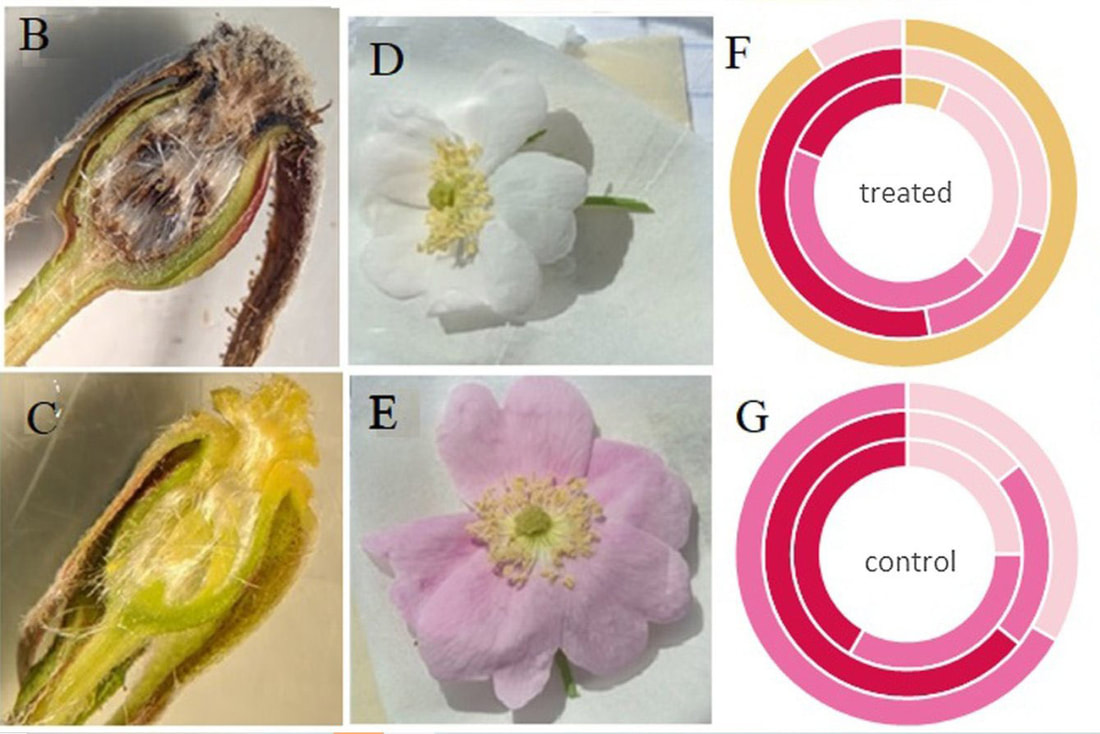|
Glyphosate-based herbicides, which are widely used in agriculture, forestry and other applications, can cause deleterious effects on the reproductive health of a common perennial plant found in forests in British Columbia, Canada. Researchers reported in the journal Frontiers in Plant Science that glyphosate-based herbicides (GBH) deformed various reproductive parts on prickly rose (Rosa acicularis) a year after the chemicals were first applied in both field sites and experimental plots. The study is one of the first to look at the effects of GBH on the reproductive morphology of a prevalent perennial plant in a commercial forestry operation. The herbicide is commonly used to control plants that could compete with conifers that are grown to be harvested in areas known as 'cutblocks'. Glyphosate has been used since the 1970s but has come under increased scrutiny in recent years over concerns about carcinogenic effects on human health. Investigators from the University of Northern British Columbia (UNBC) collected and analyzed samples of prickly rose reproductive parts from three cutblocks, as well as from greenhouse-grown wild plants, and compared them against untreated plants from similar sources. The results were striking: Pollen viability of plants treated with glyphosate dropped by an average of 66% compared to the controls a year after the initial application. More than 30% of anthers, the part of the stamen that contains the pollen, failed to split open (a process known as dehiscence), condemning these flowers to functional infertility. In addition, researchers found traces of GBH on plant flowers two full years after the herbicide was first sprayed. "The changes to plants have been documented in the past, in agricultural plants, so it is not surprising to find them in forests," said Dr Lisa J. Wood, an assistant professor in the Department of Ecosystem Science and Management at UNBC. "What is important is the timeline. To continue to find these effects one to two years after herbicide applications, in new parts of growing plants, is noteworthy." For centuries, indigenous people used prickly wild rose as both food and medicine, particularly the reproductive parts. R. acicularis is also an important plant ecologically, in part, because it provides food for pollinators. Honeybees, for example, are attracted to particular colours displayed by the flowers. Wood and lead author Alexandra Golt, a graduate student at UNBC, observed color changes in flower petals and anthers of treated plants. Such abnormalities in coloration could affect the interaction between flowers and pollinators. Wood said a follow-up study will investigate whether coloration changes in the GHB-treated flowers make them less or more attractive to pollinators. The researchers will also test pollinator insects and hummingbird faeces to check if glyphosate residue is present. "This will tell us if pollinators are taking up residues from the plants they feed on," she explained. "We will also research other plants to see if the changes we observed in the wild rose are also found in other flowers." Wood said that while past research shows glyphosate is not acutely toxic to most organisms at the levels applied commercially in Canada, scientists don't know a lot about the chronic implications of glyphosate use or how it changes the dynamics of the natural environment - such as the interactions between species or the available food quality. "The more we learn the better, and research can always be used to better inform management," Wood noted. "Herbicide practices may change, if the research shows that this is in the public's best interest." --- Glyphosate-Based Herbicides Alter the Reproductive Morphology of Rosa acicularis (Prickly Rose) Alexandra R. Golt and Lisa J. Wood Front. Plant Sci., 16 June 2021 https://doi.org/10.3389/fpls.2021.698202 Glyphosate is a broad-spectrum herbicide that is widely used in many different commercial formulations. Glyphosate-based herbicides (GBH) are used in forestry operations to reduce populations of plants that compete with merchantable conifers. Past research has found that low-dose GBH applications caused male sterility in agriculturally relevant plants, sparking a need to determine the potential impacts of forestry-related GBH applications on understory plants. We investigated the effects of GBH on the reproductive morphology of Rosa acicularis, a highly prevalent understory shrub within British Columbia, Canada, growing on three operational forestry cutblocks treated with 1.782 kg a.i./ha of glyphosate, in the Omineca Region, and also in a controlled experiment. We analyzed floral and pollen morphology from treated plants and compared these with untreated plants in both scenarios. Pollen viability of treated plants was reduced by an average of 66%, and >30% of anthers were non-dehiscent compared to controls across our three field sites and experimental plants. We also found alterations in pollen and petal morphology in flowers from treated sites and glyphosate residues present in floral tissues 2 years after GBH applications. It is important to fully understand how long GBH-induced change will impact forest vegetation, to preserve natural forest biodiversity and reduce anthropogenic influences on boreal forest ecosystems. Source: gmwatch.org
Comments are closed.
|
Archives
January 2023
Categories
All
|

 RSS Feed
RSS Feed
